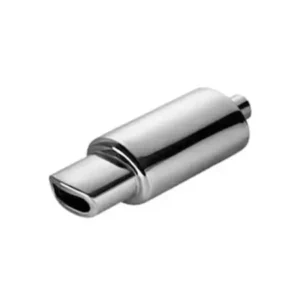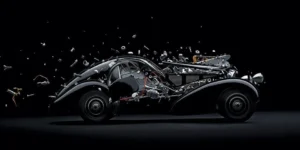The Revolution of Digital Precision in Automotive Restoration
Have you ever stared at a rare, discontinued car part and wondered how you’d ever find a replacement? Automotive enthusiasts and professionals alike face this challenge daily—tracking down that obscure 1967 door handle or recreating a custom intake manifold that hasn’t been manufactured in decades. The frustration of hunting through junkyards and online forums can feel endless, and even when you find something close, it’s rarely an exact match.
This is where the power of 3D scanning for automotive reverse engineering changes everything. By capturing precise digital replicas of physical components, today’s technology offers a revolutionary approach to preservation, restoration, and performance enhancement. Our team has transformed countless automotive challenges into success stories through this cutting-edge process.
What Makes 3D Scanning Essential in Modern Automotive Engineering
The Evolution of Automotive Reverse Engineering
Before 3D scanning transformed the industry, automotive reverse engineering relied on manual measurements and trial-and-error methods. Engineers would painstakingly measure components with calipers and micrometers, sketch designs, and create physical prototypes through lengthy manufacturing processes. According to the Society of Automotive Engineers (SAE), traditional methods resulted in approximately 40% longer development cycles and significantly higher error rates than modern digital approaches.
Today’s process looks radically different. Using high-precision scanning technology, we can capture millions of data points from a physical part with sub-millimeter accuracy in just minutes—a task that once took days or weeks.
Key Benefits of 3D Scanning in the Automotive Industry
- Unmatched accuracy: Modern industrial scanners capture details as fine as 0.025mm, ensuring perfect fit and function
- Dramatic time savings: Complex parts that took weeks to reverse engineer can now be digitized in hours
- Cost efficiency: Reduced labor, materials, and error correction expenses lower overall project costs by 30-50%
- Enhanced innovation: Digital models enable virtual testing and rapid design iterations before physical production
According to a 2023 report by the National Institute of Standards and Technology (NIST), manufacturers implementing 3D scanning technologies report an average 62% reduction in development time and a 47% decrease in production costs for replacement components.
The Complete Process: From Physical Part to Perfect Reproduction
Step 1: Assessment and Preparation
Before scanning begins, our engineers conduct a thorough assessment of the target component. This critical preparation phase includes:
- Component cleaning and surface preparation: Removing dirt, grease, and corrosion that could affect scan quality
- Structural integrity evaluation: Assessing if the part has warping or damage that shouldn’t be replicated
- Reference point establishment: Setting up alignment markers for complex assemblies
- Scanning strategy development: Determining optimal angles and positions to capture all features
“Preparation is where most DIY efforts fail,” explains James Kowalski, automotive restoration specialist at the Antique Automobile Club of America. “Professional scanning requires understanding not just the part itself, but its context in the larger assembly and its functional requirements.”
Step 2: 3D Scanning – Capturing Digital Reality
The scanning process varies based on component complexity, required accuracy, and surface characteristics. At RDS, we employ multiple scanning technologies:
- Structured light scanning: Projects light patterns onto the object, using distortion to calculate surface geometry
- Laser triangulation: Uses laser line projection to capture highly detailed surface data
- Photogrammetry: Creates 3D models from multiple 2D photographs (ideal for larger components)
- CT scanning: Reveals internal structures for complex assemblies (critical for components like engine blocks)
For automotive applications, our team typically uses a combination of these technologies to ensure complete data capture. A single exhaust manifold scan might generate over 2 million data points, creating what engineers call a “point cloud”—the raw digital representation of the physical part.
Step 3: Post-Processing – From Raw Data to Workable Model
The leap from point cloud to usable CAD model requires sophisticated post-processing:
- Data cleaning and alignment: Removing noise and aligning multiple scan passes
- Mesh generation: Creating a continuous surface from discrete data points
- Feature recognition: Identifying geometric elements like holes, fillets, and planes
- Dimensional verification: Comparing the digital model against the original part
This phase requires both powerful software and experienced engineers. “The difference between amateur and professional reverse engineering lies in this translation process,” notes The Department of Energy’s Manufacturing Demonstration Facility, which has documented how proper post-processing can reduce modeling errors by up to 95%.
Step 4: Engineering Optimization – Beyond Simple Reproduction
Here’s where the true value of automotive reverse engineering emerges. With a precise digital model, engineers can:
- Correct flaws: Identify and fix warping or wear in the original part
- Enhance performance: Optimize fluid dynamics, stress distribution, or thermal characteristics
- Material upgrades: Specify modern alloys or composites that outperform original materials
- Integration improvements: Modify mounting points or interfaces for better compatibility
A fascinating example comes from our work with a vintage racing team that needed to reproduce a rare 1960s intake manifold. By scanning the original part and optimizing the internal flow paths, we improved horsepower by 4.2% while maintaining the exact external appearance required for class authenticity.
Step 5: Verification and Manufacturing
Before production, comprehensive verification ensures the new component will perform as required:
- Digital simulation: Using finite element analysis (FEA) and computational fluid dynamics (CFD) to test performance virtually
- Tolerance analysis: Ensuring compatibility with mating components
- Manufacturing method selection: Determining optimal production approach (CNC machining, 3D printing, casting, etc.)
- First article inspection: Thoroughly testing the first produced part against specifications
“Digital verification prior to physical manufacturing has revolutionized the reliability of reverse-engineered components,” according to a recent American Society of Mechanical Engineers (ASME) study. “Components that previously required multiple production iterations now achieve specification compliance on the first attempt in over 80% of cases.”
Real-World Applications: Success Stories and Possibilities
Vintage Restoration: Preserving Automotive Heritage
The classic car restoration community has embraced 3D scanning because it solves the perennial problem of sourcing rare parts. When a client approached us with a 1953 Corvette missing critical dashboard components, we:
- Scanned similar parts from another vehicle
- Digitally restored damaged areas
- Modified the design to accommodate modern instrumentation while maintaining period-correct appearance
- Produced the components in appropriate materials
The finished parts were indistinguishable from originals to the naked eye, but incorporated hidden improvements in durability and functionality. This approach has been endorsed by organizations like the Historic Vehicle Association as a way to keep historic automobiles operational while preserving their authenticity.
Performance Enhancement: Digital Optimization
A professional racing team needed to improve their intake manifold design without violating class regulations that required stock external dimensions. Our reverse engineering services delivered remarkable results:
- Digital fluid dynamics analysis revealed flow restrictions in the original design
- Internal geometry optimization improved air/fuel mixture distribution to cylinders
- Material selection updates reduced weight while increasing thermal efficiency
- Production via 5-axis CNC machining ensured precise tolerance maintenance
The result? A 3.8% power increase within class rules—enough to move the team from mid-pack to podium contention.
Manufacturing Support: Overcoming Obsolescence
When a major automotive manufacturing facility faced a production crisis due to an obsolete transfer case component, traditional sourcing would have meant weeks of downtime. Using our 3D scanning services, we:
- Digitized the worn component in under 4 hours
- Created a production-ready CAD model by the next morning
- Improved the design to address the wear point that caused the original failure
- Used direct metal laser sintering (DMLS) to produce a replacement in 36 hours
This rapid response prevented an estimated $2.3 million in production losses, demonstrating why the National Association of Manufacturers has identified 3D scanning as a critical technology for supply chain resilience.
Choosing the Right Approach for Your Automotive Project
When to Use 3D Scanning vs. Traditional Methods
While 3D scanning offers remarkable capabilities, it’s not always the optimal approach. Consider these factors:
- Component complexity: Simple geometric shapes might be faster to model directly
- Required accuracy: For non-critical components, traditional measurements may suffice
- Budget constraints: High-precision scanning equipment represents a significant investment
- Production volume: One-off projects have different economic considerations than production runs
“The key is understanding your end goals,” advises automotive engineering consultant Michael Reeves. “For performance-critical or fit-sensitive components, the investment in professional 3D scanning pays dividends in reduced iterations and superior results.”
Key Technologies and Their Applications
Different automotive components benefit from specific scanning approaches:
| Component Type | Recommended Technology | Key Benefits |
| Body panels | Large-volume structured light | Captures complex curvature across large surfaces |
| Engine components | Laser triangulation + CT scanning | Reveals both external geometry and internal passages |
| Suspension parts | High-precision laser scanning | Captures critical alignment surfaces |
| Interior components | Photogrammetry + structured light | Balances aesthetics with functional requirements |
For comprehensive projects, our product design and 3D modeling services often combine multiple approaches to optimize results.
The Future of Automotive Reverse Engineering
Emerging Technologies Transforming the Field
The intersection of 3D scanning and automotive engineering continues to evolve rapidly. Watch for these emerging trends:
- AI-assisted feature recognition: Automating the conversion from scan data to parametric CAD models
- Mobile scanning solutions: Bringing high-precision capabilities directly to vehicles, even in remote locations
- Material property scanning: Non-destructive technologies that identify not just shape, but composition
- Augmented reality integration: Overlaying digital models onto physical components for real-time comparison
According to the Automotive Research Center, these technologies will reduce reverse engineering time by another 40-60% over the next five years.
Preparing Your Team for Digital Transformation
Organizations looking to leverage 3D scanning should consider these preparation steps:
- Skills assessment: Identify team members with spatial reasoning and digital aptitude
- Technology evaluation: Determine whether in-house capabilities or partner services best suit your needs
- Workflow integration: Establish processes for requesting, prioritizing, and utilizing scan data
- Knowledge management: Develop systems to catalog and share digital assets across projects
Or, as many organizations have discovered, partnering with established service providers like RDS can deliver immediate capabilities without the learning curve.
Getting Started With Your First Reverse Engineering Project
Checklist for Success
Whether you’re restoring a cherished classic, improving a performance vehicle, or solving a manufacturing challenge, this checklist will help ensure success:
- Define clear objectives: Specify exactly what you need from the reverse engineering process
- Gather reference materials: Collect any available documentation, even if incomplete
- Prepare the physical component: Clean and stabilize the part for optimal scanning
- Consider functional context: Understand how the component interacts with adjacent parts
- Specify critical dimensions: Identify surfaces and features where precision is non-negotiable
- Determine production method: Know how you’ll manufacture the final component
- Plan for verification: Establish how you’ll confirm the new part meets requirements
Following this structured approach dramatically increases first-attempt success rates.
Conclusion: Transforming Automotive Possibilities Through Digital Precision
The marriage of 3D scanning and automotive reverse engineering has fundamentally changed what’s possible in vehicle restoration, modification, and manufacturing. Components once considered irreplaceable can now be faithfully reproduced—often with improvements the original manufacturers could only dream of achieving with the technology of their time.
As we’ve seen through numerous success stories, the process delivers exceptional value across applications ranging from perfect historical preservation to cutting-edge performance enhancement. The digital precision offered by modern scanning technology eliminates guesswork, reduces iteration cycles, and enables innovation while maintaining compatibility with existing systems.
Whether you’re facing a manufacturing crisis, restoring a priceless classic, or seeking that competitive edge on the track, 3D scanning provides the foundation for success in today’s automotive engineering landscape.
What automotive component have you struggled to source or improve? Share your challenge in the comments, and let’s discuss how modern reverse engineering might offer the solution you’ve been seeking.
Looking for professional assistance with your automotive reverse engineering project? Contact our expert team to discuss your specific requirements and discover how our scanning and engineering services can transform your next automotive challenge into a success story.





